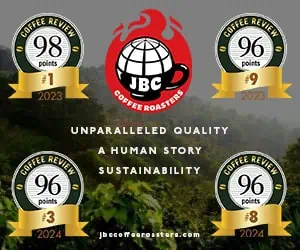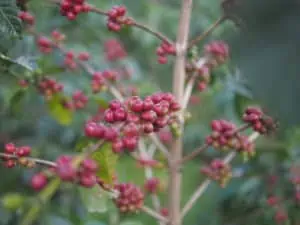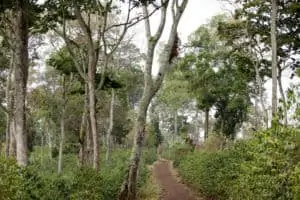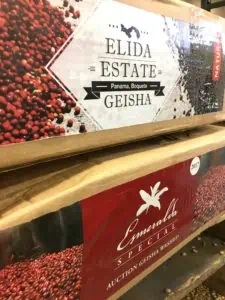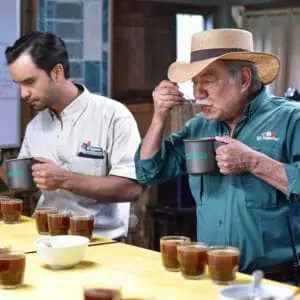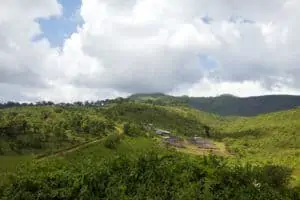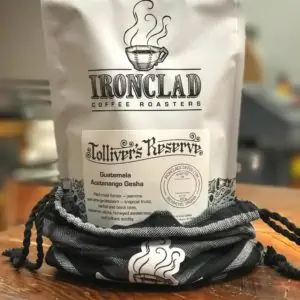I was at one of the Specialty Coffee Association’s Re:co Symposia a couple of years ago, where Jay Ruskey of Goodlands Organic, the pioneer of California coffee-growing, was displaying fresh branches of two varieties of coffee trees at his table outside the meeting rooms. Some of the branches were from the respected mainstream Caturra coffee variety, which is producing some very nice coffees on Ruskey’s Santa Barbara farm, and some were from the rare and celebrated Gesha (or Geisha) variety, also grown on an experimental basis on his farm. Ruskey invited me to taste the fruit on these two sets of branches.
The fruit from the Caturra was quite pleasant: fresh, tartly sweet, juicy, clean. And the Gesha? It was just as juicy and fresh, though a bit sweeter, perhaps a bit more tart, but above all erupting with vibrant, complex floral-toned fruit notes. The difference could not have been more dramatic. The Caturra fruit was pleasing. The Gesha fruit was complex and disconcertingly delicious.
With meticulous fruit removal and drying and a good light-to-medium roast, we have learned that that Gesha deliciousness can carry right through into the cup, producing intricately layered flowers, from lavender to lilac, crisp, floral-toned cocoa, bright citrus, aromatic sandalwood. It was this unprecedented cornucopia of aromatics that electrified the jury at the famous 2004 Best of Panama green coffee competition, when Gesha first announced its presence to the specialty coffee world. A pure, unmixed lot of Gesha from trees found growing on the Peterson family’s Hacienda La Esmeralda attracted the highest ratings ever awarded in a green coffee competition, and eventually sold for the highest price ever paid per pound for an unroasted coffee not excreted from the intestinal tract of an animal.
Sampling Gesha Coffees 13 Years Later
The emergence of Gesha is certainly one of the more electrifying stories of 21st century coffee history. We revisit that story very briefly here, but also ask, since its debut as the world’s most unique-cupping, rarest and certainly most expensive coffee, where does the Gesha phenomenon situate now? How does Gesha look in 2017 from the point of view of an aficionado consumer, now that this very rare variety has been planted in other places and other fields, including re-establishment close to its original home in the forests of western Ethiopia? Does it still taste distinctive? Does it continue to match up to its reputation? What Gesha experiences are available to the consumer, from what origins, and at what prices? To try to answer these questions, we tested 20 Geshas roasted by eight American, six East Asian, and one Canadian roasting company. Although this sampling was not as wide-ranging as we had hoped (we scheduled our story a little too early to capture some important late-arriving new-crop Geshas from Central America), it certainly offers interesting options for coffee splurges, plus gives some insight into the current situation of this history-making coffee variety.
Gesha and the Coffee Variety Question
Gesha is a variety or cultivar of the Coffea arabica species, just as Cabernet Sauvignon and Chardonnay are varieties of the Vitus vinifera grape species. There are many varieties of Arabica, but they are, in fact, mostly quite similar in their genetic makeup, as well as in how they taste in the cup. Sensory distinctions among them are occasionally striking, but more often they are not. Most of the world’s Arabica varieties ultimately derive from a few plants from Yemen, where Europeans first found the coffee tree cultivated. Because the coffee plant is largely self-pollinating (an estimated 90% of coffee flowers are self-pollinated), dramatic mutations and spontaneous crosses are infrequent and the genetic diversity of Coffea arabica is consequently quite low.
In fact, most coffee varieties are so similar in cup character that, until the emergence of Gesha, the role variety plays in determining how coffee actually tastes in the cup was not universally acknowledged. Specialty coffee insiders long contended that variety is crucial to cup character, but coffee scientists and the commercial coffee industry were not convinced—often for good reason, given that many specialty coffee tasters failed to consistently distinguish among commonly grown varieties in blind testing.
Gesha the Game Changer
Gesha changed all of that. It didn’t change the fact that coffees from most commonplace varieties still taste quite similar to one another. But what it did was conclusively prove that at least one variety, Gesha, tasted dramatically different from most of the others. And, by the typical standards of coffee experts and insiders, it also tasted dramatically better—generally bigger-bodied, usually brighter, almost always much more complex and distinctive in aroma and flavor.
It also proved, quite conclusively, that the expanding upscale end of the specialty coffee world was quite willing to pay more for a coffee variety that tasted strikingly different and strikingly good. The record-breaking price paid for that first 2004 Hacienda Esmeralda Gesha was only the beginning.
Those Scandalous Gesha Prices
A couple of months ago a particularly admired lot of Gesha sold at the Best of Panama auction for $601.00 per pound, breaking all previous records. Contrast that $601.00 with the price a farmer might receive for a pound of decent, well prepared, but not particularly distinctive Arabica from ordinary varieties sold on the same day that record price was established: $1.32.
Of course most Geshas sell to roasters for prices far, far less than $601.00, and this month we review some samples that, given Gesha’s history, rarity and unique character, could even be considered values at the consumer level.
But even these “value” Geshas are still quite pricey compared to that green coffee sold for $1.32 on the same day, a price probably far too low to adequately support the farmer and family who produced it. If prices for Geshas are too high, they only help demonstrate that prices for most decent, respectable-quality coffees are too low, and the producers of that simple but ordinary $1.32 coffee continue to have their aspirations leveled and their livelihoods strangled by the world commodity system.
A Gesha for the People?
Nevertheless, the spectacular prices paid for Geshas have dovetailed with other developments to transform the coffee industry in complex and most likely positive ways. The Gesha phenomenon coincided with the emergence of the farmer-to-roaster practices called direct trade and the erupting market for tiny, ultra-high-market lots of very specifically described coffees, significantly raising the prestige of coffee as a high-end specialty beverage. And the high prices paid for Geshas have encouraged experiment and exploration by coffee producers. Today, farmers everywhere may separate lots of unusual-looking trees in the hope that the next Gesha may show up in one of their coffee fields. And the very value and intense character of the Gesha bean has led to more and more refined experiments in subtly maintaining or influencing flavor through variations in drying and fruit removal.
Finally, and perhaps most profoundly, the Gesha phenomenon has proven to coffee breeders and researchers that cup character does count when developing new coffee varieties. It is now clear that distinctive-tasting varieties are not simply a fantasy of snob coffee buyers (or coffee reviewers). They are real, at least real enough to provoke a coffee roaster to pay hundreds of dollars per pound for a green, unroasted coffee. Coinciding with the application of genetic analysis to coffee breeding, the Gesha phenomenon has influenced the direction of the groundbreaking new research initiatives of World Coffee Research aimed at developing sophisticated new hybrid varieties of Arabica that are not only robust and disease-resistant, but also distinctive, perhaps extraordinary, in cup character.
And, hopefully, less rare and less expensive. A Gesha for the People, perhaps.
Gesha Geography, Then and Now
The paradigm-changing Gesha that Price Peterson and his son and daughter brought to the Panama competition in 2004 came from plant material that we now understand was discovered in the forests of western Ethiopia, the original home of Coffea arabica, was then carried from there to East Africa, from there to Costa Rica, and finally to Panama and that famous field on the Peterson farm.
Today, 13 years after its rediscovery, where do we find Gesha growing? In many places, though its spread across the geography of the specialty coffee world is doubtless just beginning. Most Gesha continues to be produced in Panama, on expanded farms and fields of the Peterson family; on new farms organized specifically around growing Gesha, like Ninety Plus Gesha Estates; and on well-established farms that have added Gesha to their repertoire of varieties, like Carmen Estate, which produced this month’s top, 96-rated Geisha El Palomar from Dragonfly Roasters.
Gesha production is also slowly establishing itself elsewhere in Central America and in Colombia. We recently reviewed two fine Geshas from Colombia, including the 94-rated La Palma y El Tucan Gesha from Bird Rock Coffee Roasters. Two excellent Geshas from Guatemala, both rated at 93, appear in this month’s reviews: The Willoughby’s Guatemala Legendary Gesha and the Ironclad Roasters’ Guatemala Acatenango Gesha.
The Prodigal Bean Comes Home
But perhaps the most noteworthy expansion of Gesha into the world of coffee production is not an expansion, but a return home. Gesha is now being farmed in the mountain forests of western Ethiopia, where the variety originated. In a project inspired by coffee educator and entrepreneur Willem Boot and carried to fruition by farmers Adam Overton and Rachel Samuel, superb Geshas are now being produced in western Ethiopia, close to where the variety was first discovered, produced from seed selected from trees growing wild in the nearby Gori Gesha forest. Gesha Village Estate offered its first crop at auction in 2017. Of the ten top-rated Geshas reviewed this month, five came from this new project.
Buying Those Pricey Gesha Coffees
So where does all of this leave the consumer?
(Again, a caveat on this month’s Gesha selection. The Geshas from Panama and some other Latin American origins were just arriving in roasters’ warehouses when we sourced our samples for this set of reviews, and some of the finest may not be represented here.)
Here are some observations about what we might learn from a consumer perspective from our tasting of 20 Geshas from the 2017 crop:
The very best Geshas remain great, distinctive, and alive with Geshaness. The eight coffees we rate at 94 or higher this month are all unmistakably and vividly Gesha in character. The two 93 coffees reviewed this month are also splendid coffees, though they perhaps embody a little less Gesha in their splendidness.
Unfortunately, it appears that it is possible to buy a Gesha and find that it is a good coffee, but not a particularly Gesha-like coffee. Hints for success in the hunt for a great Gesha might be: Buy from a smaller but well-established roaster, one known for quality. Look at the beans; most of them should be large and elongated. Buy from a roaster that specializes in Geshas or offers them regularly. (Mudhouse Coffee, for example, whose owners are partners in a Gesha farm in Panama. Or the very large San Francisco Bay Coffee, which outright owns a Gesha farm in Panama. Neither Dragonfly Coffee Roasters nor Willoughby’s Coffee & Tea specializes in Geshas, but both companies offer top Geshas regularly.) Buy a Gesha that has won a prize or was sold at special auction as a green coffee. (The ratings-topping Dragonfly Carmen Geisha El Palomar took fourth place in the Gesha Best of Panama competition and was sold in the subsequent auction. All of the top-rated Gesha Village Estate coffees we review this month were sold at auction by the farm.)
Or: If you want to buy the very finest, most expensive Geshas, move to Asia. East Asian consumers appear to have far fewer qualms about splurging on very distinguished, very expensive coffees like the best Geshas. Three of the top ten coffees reviewed here come from excellent Taiwanese roasters, and I suspect that the Panama Geshas have not yet reached Asia, or we would have seen even more submissions from Asian roasters. Of the 51 winning coffee lots sold in the recent Best of Panama green coffee auction (the majority of them Geshas), 37 went to roasters in Asia, seven to Australian roasters, and, yes, one to the United States—the 96-rated Dragonfly Carmen Geisha El Palomar that topped this month’s reviews.
The roast and Geshas. It appears that a really fine Gesha can stand up to a tactful darker roast and still maintain character. Note that the highest-rated coffee in last month’s August 2017 report on darker roasts was a lovely 95-rated Colombia Gesha from Amavida Coffee & Tea, brought to a roast just at the edge of moderately dark. More persuasive evidence of Gesha’s versatility in darker-roast styles comes with this month’s 94-rated San Francisco Bay Panama Geisha, a very definite though skillfully executed dark roast that wraps inside its roasty heart a sweetly pungent but recognizable version of the Gesha aromatics.
However, if this month’s small sampling is any indication, beware of ultra-light roasts. Given how expensive Gesha is, roasters may be tempted to reduce weight loss during roasting by super-light-roasting their pricey Geshas. Of the 20 Geshas we tested, two were significantly under-roasted, one grotesquely so: It was all sweet wood and snow-peas rather than sandalwood and flowers.
Processing and Geshas. Geshas appear to do well when processed by either the classic washed or wet method (fruit removed before drying; usually a cleaner and brighter cup) or the natural or dry method (beans dried inside the fruit; usually a deeper and lusher cup). The main issue is whether the processing was done well, regardless of method.
Price and Geshas. Let’s end with this one, the crinkly green elephant shuffling around the tasting table shedding high-denomination bills. Plainly, coffee from trees of the Gesha variety is expensive. Sticking with coffees with prices expressed in U.S. dollars, the least expensive coffees reviewed this month retail at $2.50 per dry ounce of beans, or about $1.25 per 8-fluid-ounce cup when brewed at home (the 94-rated, dark-roasted San Francisco Bay Panama Geisha and the 93-rated Ironclad Coffee Roasters Guatemala Acatenango Gesha).
The most expensive (again, among those with prices expressed in U.S. dollars): $9.38 per dry ounce of beans, or about $5.00 per 8-fluid-ounce cup (the 95-rated Mudhouse Gesha Village 1931, Lot 86). The highest-rated at 96, the Dragonfly Carmen Geisha El Palomar Best of Panama, comes in at $6.25 per dry ounce of beans, or around $3.00 per 8-ounce cup. The average appears to be about $5.94 per dry ounce, or about $3.00 per 8-fluid-ounce, home-brewed cup.
Admittedly, any myth of coffee as everyday luxury, the wine of the people, takes a big hit here. On the other hand, as we specialty coffee folk are endlessly fond of pointing out, three bucks for eight ounces of one the world’s greatest coffees is a bargain compared with the outlandish price one would need to pay for eight ounces of a wine of equivalent distinction.
(Coffee Review Associate Editor Jason Sarley provided valuable assistance in developing this report and its associated reviews. Thanks also to my Coffee Review colleague Kim Westerman, Barry Levine of Willoughby’s Coffee & Tea, Joseph Brodsky of Ninety Plus Gesha Estates, and to everyone who helped me with last-minute thoughts and information.)





